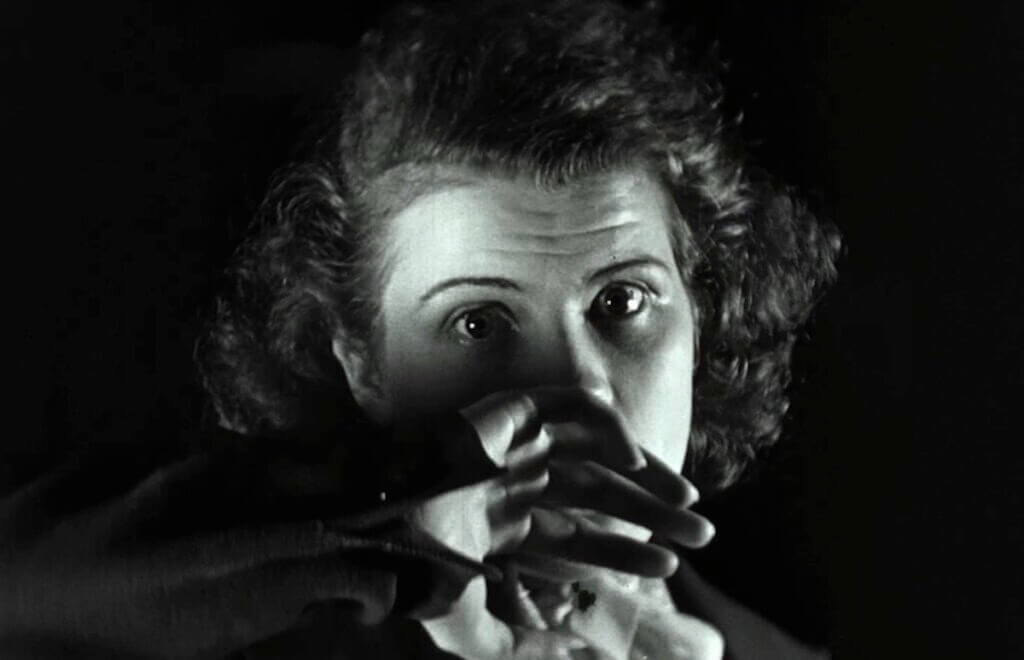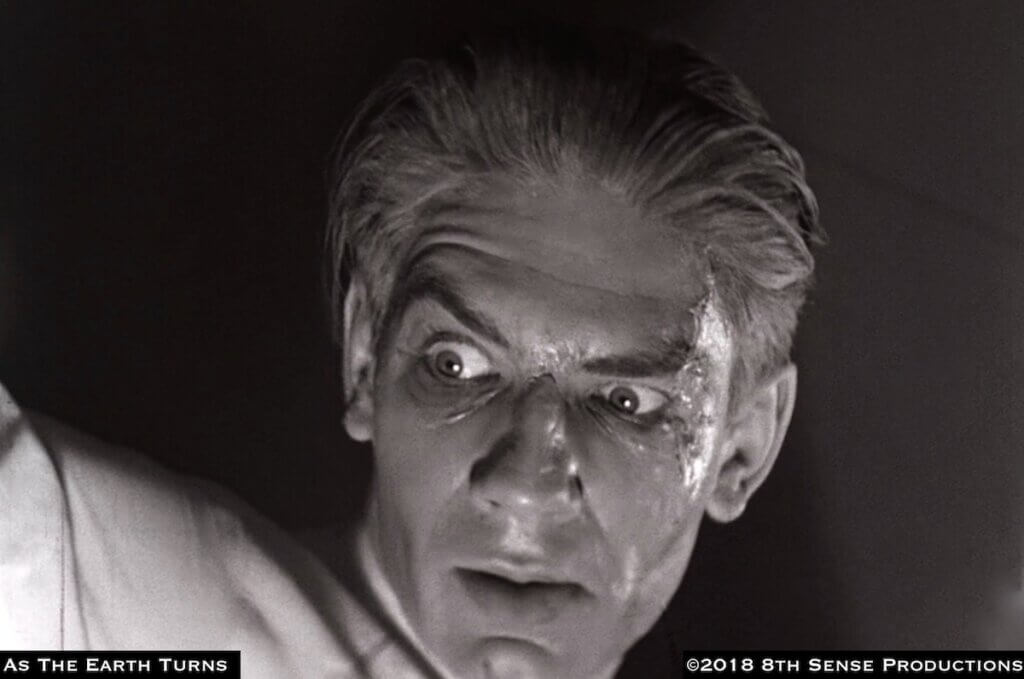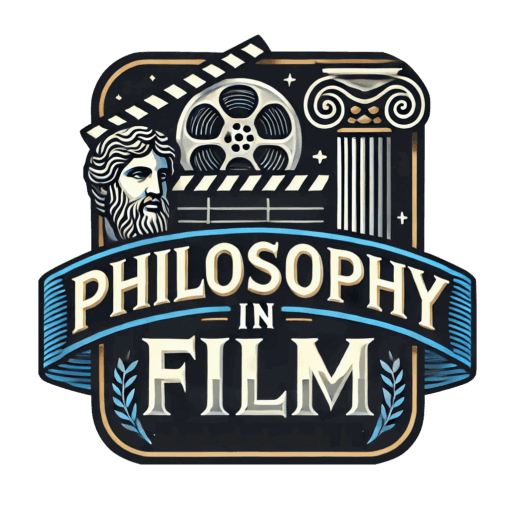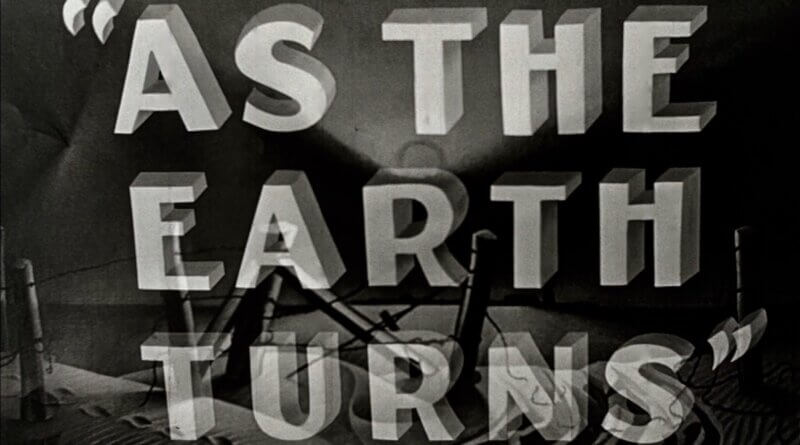Review: As The Earth Turns (1938) ★★★½
Not to be confused with the 1933 novel and 1934 film of the same name, As The Earth Turns (1938) is an independent sci-fi thriller directed by Richard Lyford. Thanks to 8th Sense Productions, As The Earth Turns has been restored and released for the first time since its creation over 80 years ago. As The Earth Turns also comes with a completely new soundtrack thanks to composer Ed Hartman. Though it is certainly not a perfect film, As The Earth Turns (1938) is a fascinating look at the early days of independent filmmaking and a surprisingly intuitive antiwar film.
As The Earth Turns begins with newsreels of war erupting in Europe. We then meet Julie (Barbara Berger), an underappreciated journalist for the New York Evening Star. She and her friend, Arthur (Alan Hoelting), ask her boss to give Barbara a chance on a real story. Barbara’s boss begrudgingly sends her to the naval radio station in Arlington, Virginia.
Once at the station, Barbara overhears a strange message from a mysterious entity known as “Pax” (Richard Lyford). The message claims that, through their control of the Earth’s rotation, Pax will increase the length of the day by 5 minutes if the United States and Europe do not bring an end to all war. The naval radio operator assumes it’s a joke, but Barbara takes the message back to her boss anyway.
When scientists see that the day has actually increased by 5 minutes, Barbara begins to take the message more seriously. Soon, more messages come in. Pax threatens to excavate a channel through the Atlas Mountains, unleashing the Mediterannean Sea onto the Sahara Desert.
Further messages threaten even more devastation across the planet if war does not come to an end. This, in turn, forces world leaders to meet in Washington, DC to discuss a peace treaty. When the peace talks break down, an earthquake rocks the planet, injuring the US president in the process. As soon as the earthquake subsides, it begins snowing in Washington — even though it’s the middle of July.
Meanwhile, Barbara and Arthur meet with Professor Lionel Banks (Edwin C. Frost) to discuss the international crisis. They conclude that nothing can be done if nations refuse to make peace. Following their meeting, Barbara witnesses a strange craft crash-landing in the forest nearby. She searches the craft, only to discover that it belongs to Pax. A map inside the craft shows the location of Pax’s base of operations.

When Arthur catches up to the crash site, Barbara is nowhere to be found. All that’s left behind is the note with the coordinates of Pax’s base. Arthur and Professor Banks take matters into their own hands to save Barbara and bring the chaos to an end.
As The Earth Turns won’t win any awards for its plot. At times, the film feels like a string of loosely related scenes strung together. However, one has to give credit where credit is due. Lyford obviously made the film on a shoestring budget as a young, ambitious director. However, Richard Lyford showed his ingenuity through special effects and prescient predictions.
First, I will address the quality of the special effects. Lyford wrote, directed, produced, and starred in this indie science fiction project. He bankrolled the film, leaving little room in the budget for big explosions. Fortunately, Lyford puts miniature sets and replicas to excellent use. The film involves futuristic UFOs, flash floods, massive earthquakes, and derailed trains, all created using old-school miniatures.
By today’s standards, the effects are laughable. It looks like a school project that a few friends put together and uploaded to Youtube. However, for the time and the budget, the special effects look better than you’d expect.
The film was shot throughout 1937 and 1938. 20 years later, big-budget science fiction films were still using UFOs on strings and miniature sets when necessary. It’s hard to criticize a young, amateur director for doing his best with what he had.
Now, on to the so-called “predictions” of the film. Since 8th Sense Productions released As The Earth Turns, they have promoted it as a “film that predicts WWII, future-technology, climate change, and the extreme need for peace.” I will address each of these assertions one by one, as some have more validity than others.

Rumors of a potential war in Europe had already begun by the mid-1930s. Adolf Hitler became the Chancellor of Germany in 1933. By 1935, Germany rejected the Treaty of Versailles and began ramping up militarization. Soon after, alliances between Italy, Germany, and Japan made war in Europe all but certain.
So, to say that the film predicted WWII is technically not wrong, but it’s a bit misleading. Richard Lyford was merely echoing sentiments of the times. Nonetheless, these predictions of war would turn out to be true just two years later when Germany invaded Poland.
As far as predicting future-technology, it’s hard to give much credit to Lyford, either. The film involves spaceships, but Georges Méliès’ A Trip to the Moon (1902) predicted this technology far earlier. As The Earth Turns also deals with technology that would allow for the complete destruction of mountains from the air. One could argue that this predicts the invention of the Atomic Bomb. In any case, every science fiction film does its best to predict the technology of tomorrow.
Next, the film predicts global warming, albeit indirectly. The film’s antagonist, Pax, has the ability to cause natural disasters at the drop of a hat. He also has the ability to change the weather. Thus, these ecological catastrophes are manmade (like global warming) and could be stopped with the end of war. While war is not the only cause of accelerated global warming, it is a potential contributor. So, in a sense, As The Earth Turns (1938) did predict manmade ecological catastrophes nearly half a century before the rest of the world caught on.
Finally, Richard Lyford supposedly predicted the “extreme need for peace.” In the post-WWI world, the need for peace was well-known. It became even more apparent after WWII and the invention of nuclear warfare. As The Earth Turns did little in the way of establishing this notion.

Now, let’s look at the film as a new release: As The Earth Turns (2018). Despite being shot in the 1930s, Richard Lyford’s work wasn’t remastered for modern audiences until 2018. It didn’t become widely available to watch until June of 2019. In any case, 8th Sense Productions did an excellent job of restoring the original film.
The soundtrack, composed by Ed Hartman, is especially praiseworthy. It matches the tone of the film well and echoes the style of many other remastered silent films. It’s impossible to say whether Richard Lyford exhibited the film with music. He usually showed his films to a select audience in his own house, with little to no press. However, Ed Hartman’s score certainly does this quirky indie film justice.
Though As The Earth Turns (1938) is not a perfect film, it is a fascinating one. The story, though somewhat farfetched, speaks of a future plagued by natural disasters and endless war. It also showcases mass destruction using miniature sets and wonderfully campy special effects. In short, if you’re a fan of silent films and over-the-top science fiction, As The Earth Turns is a real treat.
Rating: ★★★½ out of 5
If you’d like to watch As The Earth Turns (1938), it is currently available to purchase or stream for free with Amazon Prime. And if you’d like to read more reviews like this one, consult the Philosophy in Film Homepage!


I enjoyed reading, as well as browsing some of your earlier articles. I was able to see this film because it’s on Amazon Prime. Placing it firmly in the context of a low-budget work by a talented teenager, it is well worth viewing. I have some differences of opinion with you about what does or does not work about the restoration, but first I’ll try to offer some info to add value for the prospective audience.
I believe “As the Earth Turns” was in many ways an homage directly inspired by William Cameron Menzies’ 1936 feature adaptation of H.G. Wells’ “Things to Come”. As in Lyford’s film, the earlier independent production features similar-looking futuristic aircraft, similar miniature natural catastrophes/vehicle crashes and a philosopher-hero played by Raymond Massey who physically resembles Pax in Lyford’s work. Both movies make similar predictions about the imminent global conflict. As you suggest, it was generally expected to occur “soon” by the public of the time.
Homages, parodies and fan fiction are all staples of student and amateur filmmaking, and I have no objection to that. It’s a great way to learn the craft, trying to duplicate the efforts of a full crew all by yourself, or with the help of a few volunteer pals. If Lyford had released this when it was made, he would have risked copyright infringement lawsuits from the makers of the Wells adaptation. However, “Things to Come” fell into public domain some time ago, so there was no legal impediment in 2017 for 8th Sense to update, complete and release “As the Earth Turns”.
From 1991-2005 I worked as a sound editor/composer/restoration specialist for a boutique audio production house in Burbank. Most of the time was spent completing Music and Efx tracks to allow seamless dubbing into foreign languages. However, we also prepared restorations (with music) of silent classics, and some new re-edits of older releases. For Sam Peckinpah’s “Major Dundee”, we placed and mixed a newly-composed orchestral score along with the inclusion of newly-completed, previously unavailable scenes.
This past occupational experience gave me a familiarity with both music contracting for film/TV and the vast array of available royalty-free music libraries. As such, I don’t think Ed Hartman’s new score is up to professional standards. It’s clearly produced on a keyboard-based synthesizer of consumer quality, with no acoustic instrumentation. I’m assuming this was done to save money and/or to enhance Hartman’s resume for other work, as he was one of the producers of the restoration. Compare Hartman’s score with ones by Carl Davis or Robert Israel used to back DVD releases of Chaplin and Lloyd shorts to hear the difference. Just in terms of quality, 8th Sense could have done better by licensing royalty-free cues from DeWolfe, who have hundreds of CDs available in every genre imaginable.
Sometimes scores or cues must be replaced because of disputes over who owns the music rights, as happened with Michael Reeves’ “Witchfinder General”. However, adding a synth score that sounds ‘80s or newer to a film made in the distant past, or one depicting past historical periods rarely works. The most successful example I’m familiar with was Michael Mann’s “Last of the Mohicans” remake. It was originally scored entirely by synth, but once it became profitable the soundtrack was overlaid by an orchestra for all later re-releases.